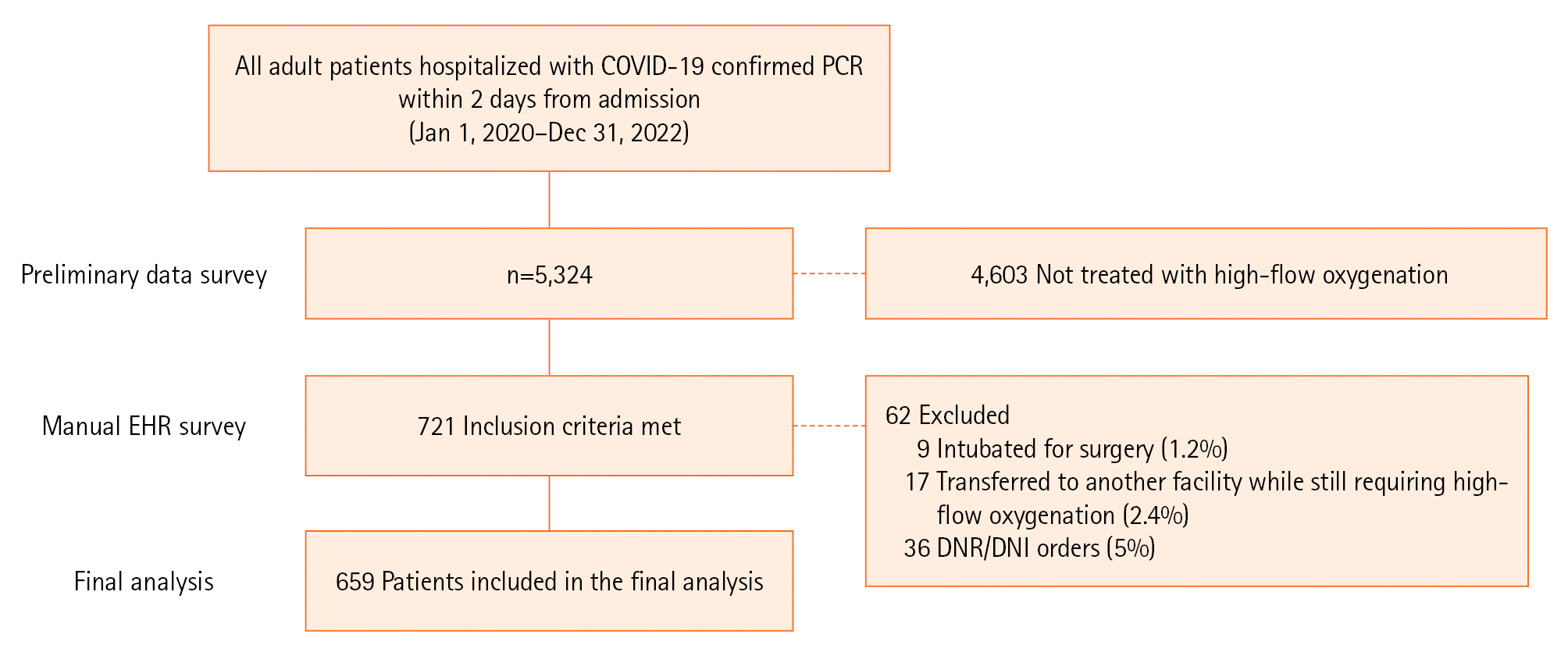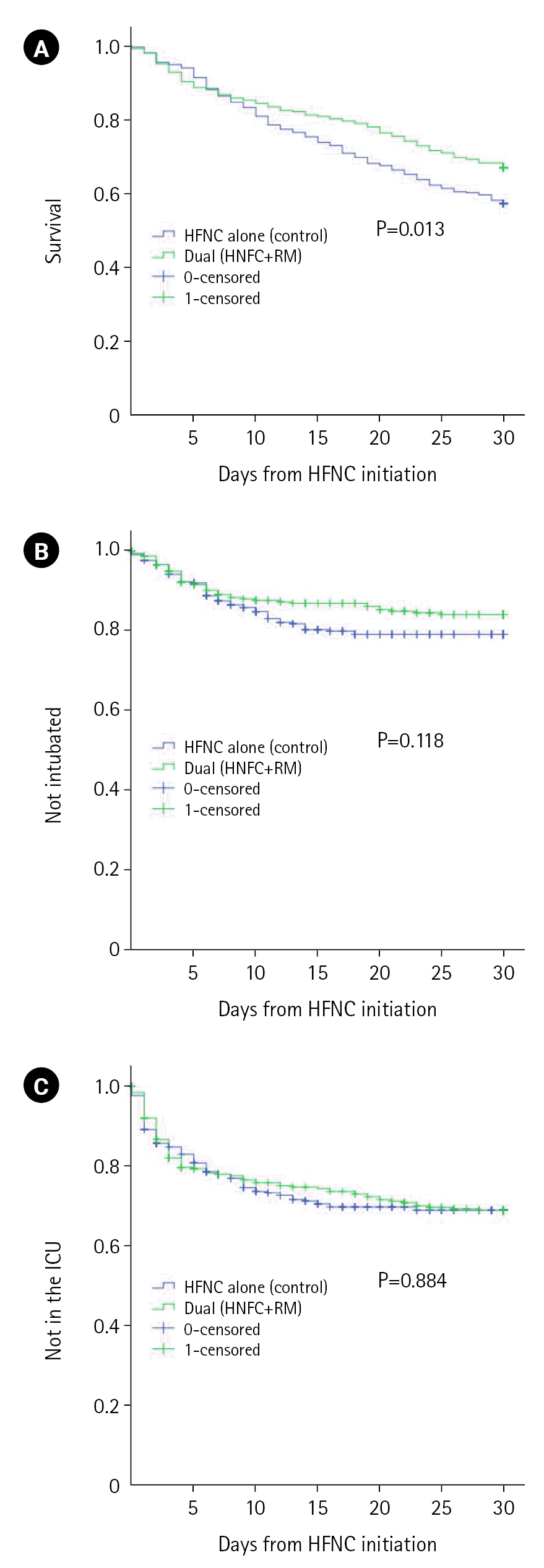Acute Crit Care.
2023 Nov;38(4):435-441. 10.4266/acc.2023.00451.
Combining reservoir mask oxygenation with high-flow nasal cannula in the treatment of hypoxemic respiratory failure among patients with COVID-19 pneumonia: a retrospective cohort study
- Affiliations
-
- 1Department of Internal Medicine, Rambam Medical Center, Haifa, Israel
- 2The Ruth and Bruce Rappaport Faculty of Medicine, Technion Israel Institute of Technology, Haifa, Israel
- KMID: 2550899
- DOI: http://doi.org/10.4266/acc.2023.00451
Abstract
- Background
Concerns regarding positive-pressure-ventilation for the treatment of coronavirus disease 2019 (COVID-19) hypoxemia led the search for alternative oxygenation techniques. This study aimed to assess one such method, dual oxygenation, i.e., the addition of a reservoir mask (RM) on top of a high-flow nasal cannula (HFNC).
Methods
In this retrospective cohort study, the records of all patients hospitalized with COVID-19 during 2020–2022 were reviewed. Patients over the age of 18 years with hypoxemia necessitating HFNC were included. Exclusion criteria were positive-pressure-ventilation for any indication other than hypoxemic respiratory failure, transfer to another facility while still on HFNC and “do-not-intubate/resuscitate” orders. The primary outcome was mortality within 30 days from the first application of HFNC. Secondary outcomes were intubation and admission to the intensive care unit.
Results
Of 659 patients included in the final analysis, 316 were treated with dual oxygenation and 343 with HFNC alone. Propensity for treatment was estimated based on background diagnoses, laboratories and vital signs upon admission, gender and glucocorticoid dose. Inverse probability of treatment weighted regression including age, body mass index, Sequential Organ Failure Assessment (SOFA) score and respiratory rate oxygenation index showed treatment with dual oxygenation to be associated with lower 30-day mortality (adjusted hazard ratio, 0.615; 95% confidence interval, 0.469–0.809). Differences in the secondary outcomes did not reach statistical significance.
Conclusions
Our study suggests that the addition of RM on top of HFNC may be associated with decreased mortality in patients with severe COVID-19 hypoxemia.
Keyword
Figure
Cited by 1 articles
-
Effect of combined reservoir mask oxygenation and high-flow nasal cannula in COVID-19 pneumonia
Dowan Kim
Acute Crit Care. 2023;38(4):507-508. doi: 10.4266/acc.2023.01480.
Reference
-
1. Macedo A, Gonçalves N, Febra C. COVID-19 fatality rates in hospitalized patients: systematic review and meta-analysis. Ann Epidemiol. 2021; 57:14–21.
Article2. Izcovich A, Ragusa MA, Tortosa F, Lavena Marzio MA, Agnoletti C, Bengolea A, et al. Prognostic factors for severity and mortality in patients infected with COVID-19: a systematic review. PLoS One. 2020; 15:e0241955.
Article3. Groff P, Ferrari R. Non-invasive respiratory support in the treatment of acute hypoxemic respiratory failure secondary to COVID-19 related pneumonia. Eur J Intern Med. 2021; 86:17–21.
Article4. Crimi C, Pierucci P, Renda T, Pisani L, Carlucci A. High-flow nasal cannula and COVID-19: a clinical review. Respir Care. 2022; 67:227–40.
Article5. Godoy DA, Graneros N, Oyarzabal L, Murillo-Cabezas F. High-flow oxygen therapy in acute hypoxemic respiratory failure secondary to COVID-19 pneumonia. Med Intensiva (Engl Ed). 2021; 45:506–8.
Article6. Vieira F, Bezerra FS, Coudroy R, Schreiber A, Telias I, Dubo S, et al. High-flow nasal cannula compared with continuous positive airway pressure: a bench and physiological study. J Appl Physiol (1985). 2022; 132:1580–90.
Article7. Gur I, Zalts R, Azzam M, Hussein K, Neuberger A, Fuchs E. Dual oxygenation in the treatment of hypoxemic respiratory failure: a retrospective cohort study. Isr Med Assoc J. 2023; 25:595–600.8. Leeies M, Flynn E, Turgeon AF, Paunovic B, Loewen H, Rabbani R, et al. High-flow oxygen via nasal cannulae in patients with acute hypoxemic respiratory failure: a systematic review and meta-analysis. Syst Rev. 2017; 6:202.
Article9. Duprez F, Bruyneel A, Machayekhi S, Droguet M, Bouckaert Y, Brimioulle S, et al. The double-trunk mask improves oxygenation during high-flow nasal cannula therapy for acute hypoxemic respiratory failure. Respir Care. 2019; 64:908–14.
Article10. Montiel V, Robert A, Robert A, Nabaoui A, Marie T, Mestre NM, et al. Surgical mask on top of high-flow nasal cannula improves oxygenation in critically ill COVID-19 patients with hypoxemic respiratory failure. Ann Intensive Care. 2020; 10:125.
Article11. Mälberg J, Hadziosmanovic N, Smekal D. Physiological respiratory parameters in pre-hospital patients with suspected COVID-19: a prospective cohort study. PLoS One. 2021; 16:e0257018.
Article12. Duprez F, de Terwangne C, Bellemans V, Poncin W, Reychler G, Sorgente A, et al. High-flow nasal cannula therapy, factors affecting effective inspired oxygen fraction: an experimental adult bench model. J Clin Monit Comput. 2022; 36:1441–8.
Article13. Mauri T, Alban L, Turrini C, Cambiaghi B, Carlesso E, Taccone P, et al. Optimum support by high-flow nasal cannula in acute hypoxemic respiratory failure: effects of increasing flow rates. Intensive Care Med. 2017; 43:1453–63.
Article14. Dogani B, Månsson F, Resman F, Hartman H, Tham J, Torisson G. The application of an oxygen mask, without supplemental oxygen, improved oxygenation in patients with severe COVID-19 already treated with high-flow nasal cannula. Crit Care. 2021; 25:319.
Article15. Born P, Castro R. A combination of Bohr and Haldane effects provide a physiologic explanation for the increase in arterial oxygen saturation when a face mask is added to a high-flow nasal cannula in severely hypoxemic COVID-19 patients. Crit Care. 2021; 25:395.
Article16. Swenson ER. Does inspiration of exhaled CO2 explain improved oxygenation with a face mask plus high-flow nasal cannula oxygen in severe COVID-19 infection? Crit Care. 2021; 25:343.17. Ritchie JE, Williams AB, Gerard C, Hockey H. Evaluation of a humidified nasal high-flow oxygen system, using oxygraphy, capnography and measurement of upper airway pressures. Anaesth Intensive Care. 2011; 39:1103–10.
Article18. Lee CC, Mankodi D, Shaharyar S, Ravindranathan S, Danckers M, Herscovici P, et al. High flow nasal cannula versus conventional oxygen therapy and non-invasive ventilation in adults with acute hypoxemic respiratory failure: a systematic review. Respir Med. 2016; 121:100–8.
Article
- Full Text Links
- Actions
-
Cited
- CITED
-
- Close
- Share
- Similar articles
-
- Effect of combined reservoir mask oxygenation and high-flow nasal cannula in COVID-19 pneumonia
- High-flow nasal cannula for respiratory failure in adult patients
- Treatment of acute respiratory failure: high-flow nasal cannula
- The Effect of Oxygen Asministration by Reservoir Tube During Immediate Postoperative Period
- Factors about Failure after High Flow Oxygen through Nasal Cannula Therapy in Hypoxic Respiratory Failure Patients at Emergency Department Presentation




